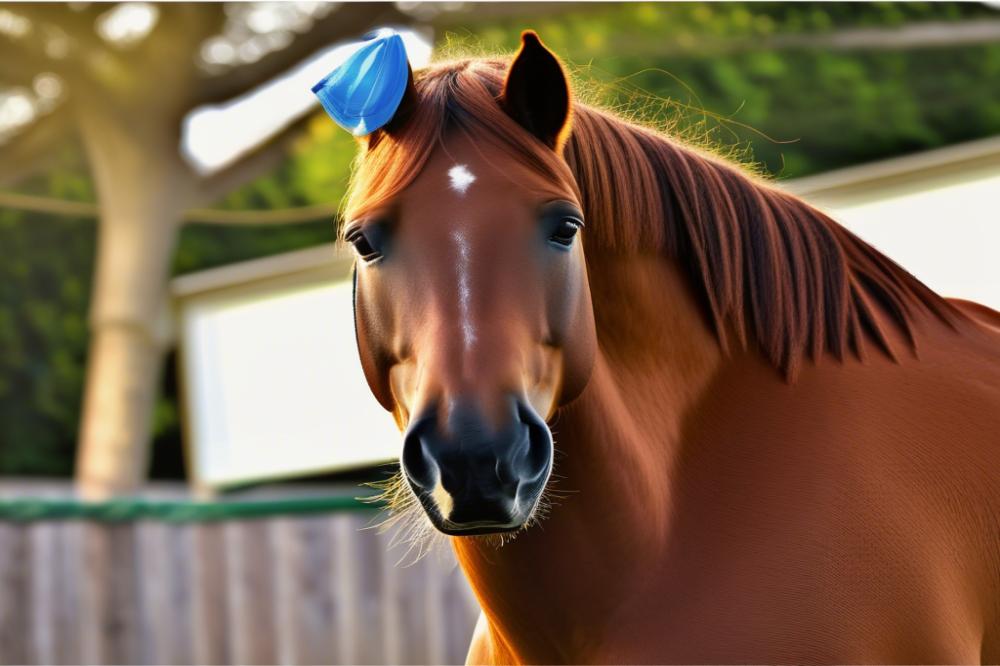Warts in Horses: Understanding This Common Skin Condition
When you think about horses, adorable hoofed companions come to mind. However, there are a few equine issues that can throw a wrench in the gears of horse care. One such issue is warts. These growths, also known as equine papillomas, may not be as cute as a foal playing in the pasture, but they are quite common among all breeds of horses.
Warts often manifest as small, raised bumps on a horse’s skin, usually around their face, mouth, or eyes. They may start off looking like tiny pimples before growing larger and becoming more noticeable. Although they can be an eyesore, especially for those horses that parade around at shows, warts are generally harmless. It’s like a teenager growing awkwardly in their sneakers—sometimes a bit weird, but it’s just part of growing up, right?
In terms of prevalence, these skin conditions are most frequent in young horses, particularly those under three years old. Their immune systems are still maturing, which makes them more susceptible. Picture a young horse navigating the world, much like a toddler learning to walk—trip and fall, trip and fall. Some warts may fade away on their own as the horse’s immune system strengthens, just like a child growing out of their stubborn habits. Knowing about wart treatment options can help ensure that your horse remains comfortable and healthy.
Horse owners and caretakers need to understand warts as part of the broader picture of horse health. Warts might seem trivial, but being aware of this skin condition can help prevent potential misdiagnoses or unnecessary worry. Imagine spotting a bump and panicking—only to realize it’s just a harmless wart and not something more serious. Now that would surely feel like finding out you can’t really ask, “can a horse eat chocolate?” after all!
In the grand scheme of equine care, recognizing warts allows owners to take proactive steps while reinforcing their bond with their horses. After all, understanding and addressing skin conditions like warts is part of being a conscientious caretaker. Just as you wouldn’t ignore a scrape on your own knee, overlooking these little bumps can leave horse owners feeling in the dark when it comes to their beloved companions’ health. Remember, keeping your horse healthy is just as important as ensuring the barn is clean and the hay is fresh!
What are Warts in Horses

Warts in horses can be quite the sight! These small, rough growths, often resembling tiny cauliflower heads, typically appear on various parts of a horse’s body. They can show up on the face, particularly around the lips, or even under the chin. While they may look peculiar, these growths are generally harmless.
There are different types of warts. Some are caused by a virus, while others are benign growths that won’t bother your horse at all. Viral warts, also known as equine papillomatosis, usually affect younger horses, while older horses may develop non-viral benign growths. It’s fascinating how these two types can pop up on the same horse but with different backgrounds!
Not all skin conditions are the same, and warts are no exception. They differ from other issues like rain rot or hives, which can cause itching and discomfort. Warts don’t typically bother horses much. Most of the time, they will trot around without even noticing they have a little extra ‘decoration’.
As for horse care, it’s essential to keep an eye on any growths. Change in appearance or sudden increase in number could signal an equine issue that needs attention. While wart treatment is often not necessary, knowing what’s normal for your horse can help spot potential problems before they escalate.
If you ever find yourself scratching your head over skin conditions in horses, remember, warts are usually a pretty low-maintenance issue. Understanding them is just one piece of the puzzle in ensuring good equine health.
Causes of Warts in Horses

Warts in horses often arise from a pesky little culprit known as the equine papillomavirus. This virus is primarily responsible for the growth of these skin conditions. Young horses seem to attract this issue more frequently than their older counterparts. Why? Their immune systems are still developing, making them a prime target for infections and other equine issues.
Another factor to think about is the overall health of the horse’s immune system. A solid immune system can help ward off this virus. Just like humans, horses can struggle with warts when they’re under stress or unwell. Consider the common factors. Poor nutrition, lack of proper horse care, and even fatigue can weaken defenses.
Environment plays a crucial role, too. Horses kept in crowded conditions are more likely to share germs and viruses. Think about horse shows or stables where many animals congregate. It’s like sharing a lunch table at school and catching a cold. Keeping a watchful eye on stable conditions is key to preventing warts.
Also, keep an eye on how your horse interacts with others. Horses that practice less social distancing might pick up the virus from their peers. Biting flies can spread the virus. Insects buzzing around can be more than just a nuisance, they can be a vector for equine health issues.
Ultimately, while warts themselves aren’t usually harmful, they can be annoying for both horses and their owners. Wart treatment often isn’t urgent, but it can become necessary if warts cause discomfort or interfere with daily life. Owners should stay informed and proactive about their horse’s skin conditions. Regular checks can help to catch these growths early and spot any signs of other issues.
Symptoms and Diagnosis

When it comes to spotting warts in horses, you want to keep your eyes open for a few telltale signs. Bumps or lesions can pop up on the skin, generally in areas like the face, around the eyes, or even on the legs. These growths often resemble small cauliflowers. If you notice something unusual on your horse’s skin, it’s always worth paying close attention.
Skin conditions can affect any horse, but knowing the symptoms is crucial for equine health. The warts themselves can vary in size, color, and texture. They often feel soft to the touch, and in some cases, they might be itchy. A horse that starts rubbing its face or legs against fences or trees could be trying to relieve that itchiness. That’s a good indication something might be bothering them.
To dig deeper into a diagnosis, it’s wise to consult a veterinarian. A thorough veterinary examination is key. The vet will likely look at the warts and assess your horse’s overall health. They may ask questions about the horse’s habits, any recent changes in the barn or pasture, and other signs of equine issues.
In some situations, a vet might recommend tests. While warts aren’t usually serious, getting a professional opinion can rule out other skin conditions. The last thing you want is to miss something more concerning while fixating on wart treatment.
During the exam, the vet may also discuss your horse care routine. Feeding, grooming, and living conditions all play a role in horse health. Keeping up to date with vaccinations can help prevent other issues that might arise alongside warts.
Remember, early detection is vital. Don’t hesitate to ask questions or express concerns during the visit. A bit of humor can lighten the mood while discussing these equine problems. After all, every horse owner wants their buddy to feel happy and healthy!
Treatment Options
Warts can be a nuisance when it comes to horse care. Understanding the types of treatment available is key to maintaining equine health. Some methods require a light touch, while others might need a more hands-on approach. Horse owners have a few choices in how to handle skin conditions, including observational methods, surgery, and topical medications.
Observational Approach
Sometimes, just keeping an eye on the growth is enough. Warts often don’t cause any pain or discomfort. They might even disappear on their own. Monitoring your horse closely is important. If you see any changes, make a note. If the warts worsen or spread, it might be time to consider other options. Remember, staying calm and collected helps your horse, too.
Surgical Options
Surgery is another option for wart treatment, especially when warts interfere with the horse’s comfort or performance. Veterinarians can remove them through minor procedures. This method can offer quick results, but it does come with its own set of challenges. Make sure to discuss potential risks and benefits with your vet beforehand. It’s important to keep this part of horse health in check.
Topical Medications
Topical treatments can also be used to handle skin conditions in horses. Medications applied directly to the warts might encourage healing or shrinking. Some may contain ingredients that fight off any potential infection while others help to soothe the skin. Always follow the vet’s guidance when using these products. They know the best products suitable for your horse’s specific needs.
When to Seek Veterinary Care
Knowing when to call the vet is crucial. If warts bleed, change rapidly, or cause your horse distress, don’t hesitate to seek professional help. Your veterinarian can offer advice tailored to your situation. This might mean performing tests or even suggesting a more comprehensive treatment plan.
Home Remedies
Some folks love to try home remedies for equine issues. Natural options range from apple cider vinegar to herbal concoctions. While these might seem appealing, their effectiveness can vary. Always proceed with caution and do your homework first. Simple solutions can sometimes do the trick, but be wary of those that could irritate the skin further.
Staying informed is vital for any horse owner. By knowing how to manage warts, you can ensure your horse remains healthy and happy. Take care of your horse’s skin with patience and, when in doubt, don’t shy away from calling in the professionals.
Prevention Strategies
When it comes to keeping your horse healthy, prevention really is better than cure. Taking a few simple steps can make a big difference in avoiding skin conditions that no one wants. First off, proper hygiene is key. A clean environment helps keep germs at bay. Regularly clean the stable and remove any waste materials. This practice can greatly limit the chance of equine issues developing, including warts.
Grooming your horse matters, too! A proper grooming routine not only keeps your horse looking fabulous, but it can also spot early signs of skin problems. Use clean tools for grooming. Tools should be washed regularly to avoid spreading anything nasty. Remember, sharing isn’t always caring!
To further enhance horse care, check for any potential health issues. Make a habit of examining your horse’s skin regularly. Look for unusual lumps or bumps. If you notice anything out of the ordinary, consult with your veterinarian. Early detection can make a world of difference.
Think About Vaccination
Vaccination plays a role in equine health. While there isn’t a specific vaccine just for warts, keeping up with general vaccinations helps build a strong immune system. Strong horses are less likely to develop various conditions. Talk to your vet about what vaccinations are appropriate for your horse.
A well-balanced diet also contributes to good skin health. Quality feed can help boost the immune system, which works overtime to fend off unwanted skin problems. Fresh water is crucial, too. Horses need hydration just like we do. A well-hydrated horse is happier and healthier.
Stable Management
Good management practices in stable environments can help prevent the spread of various conditions. Avoid overcrowding in stables. Give each horse enough space to feel comfortable. Too much close contact can lead to sharing of germs and other issues. You wouldn’t want a crowd of sneezing horses, right?
If you have several horses, consider separating new arrivals for a brief period. It’s like a quarantine for your equine friends. This provides time to observe any potential problems before they mingle with the others. Think of it as a “get to know you” time without the drama!
One last tip: try to keep your horse from rubbing against things. This can scratch their skin, making it more susceptible to infections and skin conditions. It’s like wearing a band-aid on a scraped knee; protect the area as best you can.
Warts and Horse Health
When we talk about warts in horses, it’s natural to wonder how these little bumps affect overall well-being. Surprisingly, warts can impact equine health in several ways. While many may view them as mere annoyances, they can lead to more significant issues. They might not hurt, but they can cause discomfort. Imagine riding a horse with warts on its face or legs. That’s not pleasant for the rider or the horse!
Warts develop due to a virus, usually relating to the equine papillomavirus. This virus doesn’t act alone; it thrives when a horse’s immune system is weaker. Think of it like a campfire. If the flames are strong, they keep the cold out. However, if the fire diminishes, the cold can creep in. Strong immunity helps fend off such skin conditions. A healthy horse is like a well-built fortress against many diseases.
Furthermore, horse care plays a vital role. Owners must observe their horses regularly. Some might not realize that even small issues can flare up if not addressed. Warts can sometimes become infected or irritated. This irritation may lead to complications requiring wart treatment. Infections can cause pain, fever, or even more trouble down the line.
Understanding the connection between warts and the immune system is crucial. The body’s defense is a complex system. Some horses may develop warts due to exposure to the virus and may not show symptoms. However, other horses with weaker immune systems might develop numerous warts. This variation often surprises horse owners. There have been instances where the horse’s overall health has improved dramatically after treating the underlying viral infection. Taking care of equine issues promptly is the key.
While not every wart necessitates drastic action, it’s wise to keep an eye on them. Regular grooming and close inspections can keep you informed. If your horse starts to appear uncomfortable or the warts seem to multiply, seeking guidance from a vet might be the best bet. In essence, good horse health requires vigilance. Like a soccer coach watching each player closely, monitoring your horse’s skin condition helps maintain its well-being.
In the end, warts might seem like a small issue, but they can be a signal of larger concerns. A little diligence can save a whole lot of hassle later. Keep your horse’s health in tip-top condition, and you’ll avoid multiple headaches down the road. After all, happy horses lead to happy owners!
Wrapping Up the Talk on Horse Warts
In summary, warts in horses are a common issue that many horse owners may encounter. Understanding what they are and how they impact our equine friends is crucial for any responsible caretaker. These growths, while often harmless, can sometimes lead to discomfort or secondary infections. So, recognizing the signs early can make a big difference.
Having a watchful eye on your horse’s health is essential. Simple daily check-ins can help spot those little growths before they become a larger problem. Remember, knowledge is power. It can feel a bit like trying to pick a favorite from a horse movie for kids—there’s so much variety, and you want the best for your companion.
Preventive measures are just as important. Keeping your horse’s environment clean, making sure they are living in good conditions, and maintaining proper hygiene can help ward off warts. Just like saying “an ounce of prevention is worth a pound of cure,” a little effort can go a long way in keeping your horse healthy and happy.
If warts do pop up, don’t panic! Consulting with a vet is key. They can suggest treatments ranging from simple topical ointments to, in some cases, minor surgical procedures. Being proactive is all part of being a good horse parent.
Understanding the differences in riding styles, like English vs Western riding, can also inform how we care for our horses, including their grooming routines and exposure to other equines. The more you know, the better you can care for your friend.
In the end, whether your horse is out there trotting around or enjoying a leisurely stroll with you, keeping them healthy is the priority. Just remember that with the right approach, these little growths are just a bump in the road in the grand journey of caring for our beloved horses. After all, it’s their happiness and health that matter the most.



